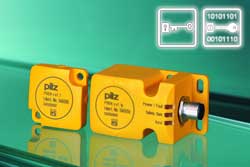
Posted to News on 2nd Dec 2007, 17:17
Change to EN 1088 tightens guard interlocking requirements
Kevin Ives, a consultant with Pilz Automation Technology, explains the new addition to EN 1088 that makes important recommendations relating to the specification and installation of guard interlocks.

In July 2007 EN 1088:1995 (Safety of machinery. Interlocking devices associated with guards. Principles for design and selection) was amended by the addition of A1:2007. Rather than write a new version of EN 1088, CEN has issued amendment A1, which relates specifically to section 5.7 of EN 1088:1995. It can only be used in conjunction with the full standard, as there are references to tables and figures in that standard.
Clause 5.7 covers 'Design to minimise defeat possibilities'. Research into the reasons why operators try to defeat interlocks has shown that the need to defeat safety systems stems from shortcomings in the design of the machine.
Clause 5.7.1 offers advice on the basic specification of the safety function. The aim should be to design a safety function wherein measures to minimise the possibility of defeat are implemented at system level, so there is not a total reliance on the interlocking device itself. This can include monitoring in the non-safe control system. Measures such as forced cyclical testing, status indication and time limitations can be programmed to supplement the safety system.
The other main addition is the need to specify the interlocking function so that measures for minimising the possibilities for defeat are achieved by removing the foreseeable reason for attempting to defeat the interlocking device.
Furthermore, this section goes on to define how to combat "defeat in a reasonably foreseeable manner." It should not be possible to defeat an interlock with readily available objects such as:
- Screws, needles or sheet metal pieces
- Objects in daily use such as keys, coins, adhesive tape, string and wire
- Spare actuators or spare keys for trapped-key interlocking devices
- Tools required for the intended use of the machine such as screwdrivers, wrenches, Allen keys and pliers
The recommendation is to use coded devices or individual coded devices (dependant on the results of a risk assessment). These could be mechanical, electrical, magnetic or optical, used either singly or in combination.
There is also a recommendation to use additional sensors as shown in figure 4 in the main body of the standard.
Clause 5.7.2 defines the types of switches and specific requirements. The main addition is the need to secure the switches by fastenings that cannot easily be removed or loosened. This includes welding, riveting, one-way screws, etc.
The same is true for tongue-type switches and any other switches that have separate actuators. The standard suggests that when the gate is open, the switch is shielded so that spare actuators can not be used. This is achieved by good design of the interlock fixings.
In conclusion, this addition to the standard encourages better design of machinery to reduce the temptation to defeat safety devices, but it also tightens up on the measures to ensure that safety devices are more difficult to defeat.
Please contact Pilz to request more information about coded safety switches by emailing [email protected] or visit www.pilz.co.uk.
Want the latest machine building news straight to your inbox? Become a MachineBuilding member for free today >>

















